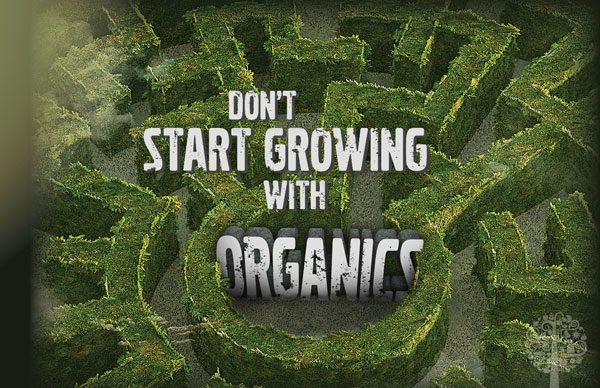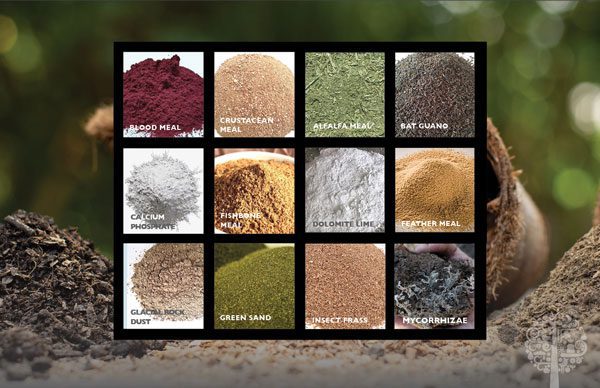Novice growers typically overestimate the complexity of hydroponics. They also invariably underestimate the complexity of organics. They misconstrue hydroponics as being for geeks in lab coats and organic gardening as the easy way to grow; just plant in some soil and let Mother Nature do the rest. Yeah, good luck with that.
All Organic Or Nothing?
I cringe a little when someone relatively new to indoor gardening insists from the outset that everything they do must be 100% organic. It’s a noble goal, for sure, especially if the aspiring organic gardener is informed. More often than not, however, the word organic represents little more than a vague notion of ‘all-natural’.
Many organic growers often shun mineral-based fertilizers. But the climax of all the interactive microbiological activity in healthy organic soil mineralizes things. Organic, carbon-based inputs like feather meal, alfalfa meal, blood meal, bone meal, and chicken manure are collectively broken down into their ionic mineral forms by the likes of worms, nematodes, protozoa, fungi, and bacteria in the soil. Only then is all the organic goodness in the earth water-soluble and available to plants. I’m not trying to diminish the magic of microbes, but by the same token, please don’t demonize minerals either!
When To Grow In Soil
When planning to cultivate fast-growing, heavy-fruiting annuals in containers indoors, then my recommendation is to not grow in soil. Nursery pots, intermediate pots (1L-2L or half-gallon), and some final stage fabric pots (5L-10L or 3-5 gallon) are suitable, but fill them with a good quality 70/30 coco/perlite soilless potting mix. Choose a liquid feed explicitly designed for the full plant lifecycle in coco coir. If in doubt, ask your local indoor gardening store.
Tools Of The Trade
Buy a TDS/conductivity meter (and ideally a pH meter too), take your time in propagation, and always make sure you achieve 15-30% run-off during irrigation. Don’t let the plants sit in any moisture. Take it easy with nutrient strength (start at 200-300 PPM / 0.4-0.6 mS, and never go above 1000-1100 PPM/2.0/2.2 mS, unless it’s a super heavy feeder like an eggplant/aubergine).
I am confident that these tidbits of advice mixed with some common sense and rudimentary environmental control will help any grower achieve decent results. Sure, growing in coco coir with mineral-based nutrients is unlikely to win the crop an official organic certification, but at least you will succeed.
Possible Problems
Growers who begin with potting soil can end up facing many complications. If planning on adding water throughout the plant lifecycle, then an upgrade in pot size is essential. Select a much bigger pot, around 40L or 10 gallons, to act as a sufficiently large reservoir of organic nutrition for the plant’s entire lifecycle. A rich potting mix is also required. Ultra-premium potting mixes work well, but they don’t come cheap. Also, they’re invariably far too nutrient-rich for seedlings and cuttings, so a lighter seed starting mix is needed when the plants are just starting.
Soil vs Soilless Potting Mixes
Both types of potting mix are often based on the same fibrous materials such as coco pith/fiber and peat moss. Soilless potting mixes are not always inert/nutrient-free, and can sometimes contain organic inputs such as bat guano.
The critical difference between the mixes is the presence or absence of compost. Soil-based potting mixes invariably contain some compost (around 15% of total volume). They will always include some organic, powdered nutrition such as bat guano, seabird guano, bone meal, and rock phosphate.
An alternative approach is to use a soil-based potting mix that is lighter in organic nutrition and add extra food periodically using organic liquid feeds and top dressings. These dressings are usually powdered organic inputs mixed with compost and applied around the base of the plant.
The positive effects of adding nutrition take a while to reveal themselves in plants. It takes experience to gauge how much to add and how often to get the desired result. Soil-based potting mixes are also easy to overwater. They are not nearly as forgiving as a 70/30 coco/perlite mix. Furthermore, in contrast to working with coco coir, soil growers typically don’t aim for run-off each time they water, as this washes the nutrition out of the soil. So getting the irrigation right, especially given that it’s a moving target, can be a lot trickier.
What if the humidifier quits in the third week of veg and the grow shop is closed? If you’re growing in a coco/perlite mix, you can react by dropping the nutrient strength by 25-30% and increasing irrigation frequency slightly to counter the increased transpiration levels and calcium uptake. If you’re growing in a soil mix, then your options for damage control are limited.
My Advice?

To be clear, I’m not anti-organics. My outdoor soil beds are a testament to this fact. But they are also the result of thousands of dollars worth of premium organic inputs. Large, outdoor soil beds are one thing; trying to regulate and control adequate natural nutrition in containers indoors is another.
My advice is to focus first on growing something full lifecycle. Get to the finish line whatever way you can. I promise you will be glad that you chose not to limit and constrain your options before you were even out of the gate.
DIY SOIL RECIPE
After following this recipe, wet the mix with water and allow to compost and pH stabilize for a month before use.
BASE POTTING MIX
- 30% sphagnum peat moss
- 10% redwood bark
- 10% coco coir
- 20% perlite
- 5% lava rock
- 15% compost
- 5% worm castings
- 5% Alaskan humus
Add nutrients relative to the amount of base potting mix.

BAT GUANO
4lbs per cubic yard of base potting mix
67g per cubic foot
2.37g per liter
SEABIRD GUANO
4lbs per cubic yard of base potting mix
67g per cubic foot
2.37g per liter
BONE MEAL
4lbs per cubic yard of base potting mix
67g per cubic foot
2.37g per liter
POTASSIUM SULFATE
2lbs per cubic yard of base potting mix
33.5g per cubic foot
1.185g per liter
FINE DOLOMITE LIME
2 lbs per cubic yard of base potting mix
33.5g per cubic foot
1.185g per liter
FEATHER MEAL
1lb per cubic yard of base potting mix
16.25g per cubic foot
0.59g per liter
AZOMITE®
1lb per cubic yard of base potting mix
16.25g per cubic foot
0.59g per liter
DRY POWDERED SEA KELP
1lb per cubic yard of base potting mix
16.25g per cubic foot
0.59 g per liter
ALFALFA MEAL
1lb per cubic yard of base mix
16.25g per cubic foot
0.59g per liter
Watch Everest make this soil mix here:
The following are alternatives to organic inputs in soil mixes and top dressings. Additives such as blood, bone, and crustacean meal, and bat guano are considered natural, but many growers don’t use them because they come from animals.
Blood Meal: Dried blood, not for the squeamish. Same NPK as feather 12-0-0. Very expensive. Contains iron. Very high protein content. Fine, water-soluble.
Calcium Phosphate: Cheap and delivers phosphorus and calcium. Popular with organic growers. Issues with contaminants (Uranium, Plutonium, cadmium, arsenic). Not recommended for growing medicinal plants.
Crustacean Meal: Combination bi-product of ground-up lobster, crab, and shrimp shells. High nitrogen content, along with potassium and calcium. Chitin in the crustacean meal provides a defensive response in plants against insect predation so that it can act as a beneficial pest preventative.
Fishbone Meal: Store in dry conditions. Susceptible to mold. High nitrogen and phosphorus content.
Glacial Rock Dust: Trace elements, soft rock phosphate. High phosphorus mined rock with a 0-3-0 ultra slow release. Not recommended for short cycle plants.
Green Sand: Sand or sandstone with a green color. High silica levels. Another mined product. Similar to glacial rock dust.
Insect Frass: Broad-spectrum fertility and a hit of beneficials. Also contains chitin.
Mycorrhizae: Cheaper to use in transplant (direct contact with roots) rather than blending with potting mix. Relationships tend to be long-term, so there’s an argument that this is better suited for cultivating larger, older plants.